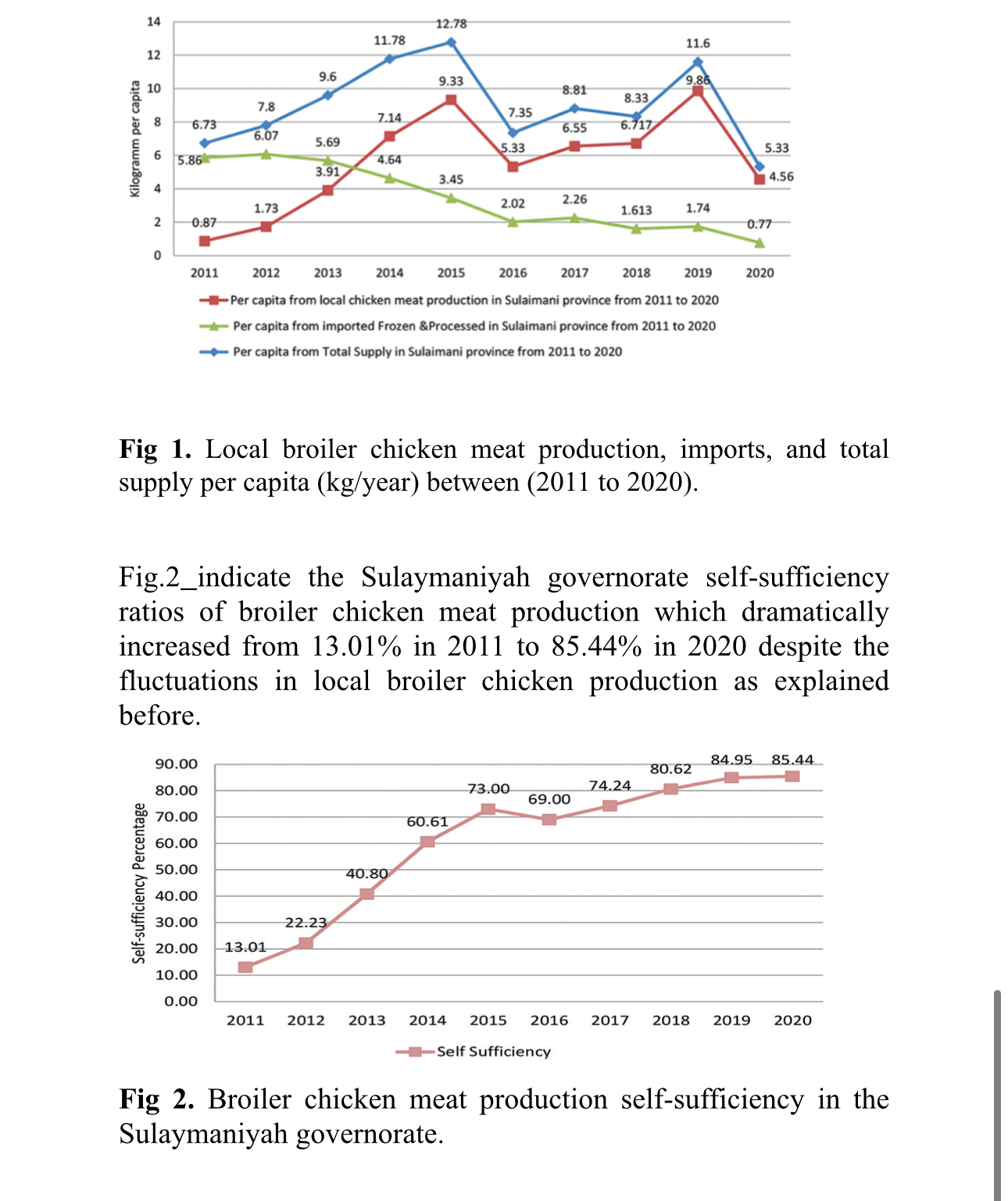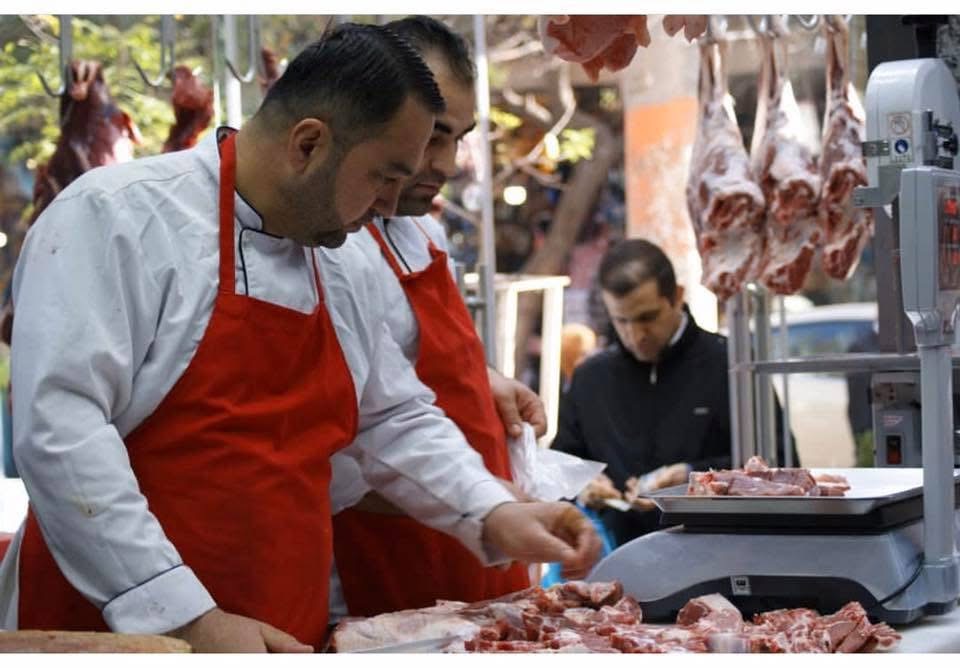The growing demand for meat as important protein source is closely linked to urbanization, improving living standards, dietary changes, and affordable prices. Among various meat types, poultry, especially broiler chicken meat, has become a popular choice worldwide due to its quality and accessibility. Reports predict that per capita poultry meat consumption will significantly increase in developing countries over the next decade.
In Iraq and the Kurdistan Region (KRI), meat holds a special cultural and social value. It is an integral part of Kurdish cuisine, enjoyed for its rich flavor and nutritional benefits, including high-quality protein, essential minerals, vitamins, and other micronutrients crucial for a healthy life. Over the last two decades, poultry meat consumption in the region has grown significantly, particularly following the 2003 economic boom. This development widened the gap between local production and consumer demand, leading to increased food imports to meet the shortfall. Furthermore, rising household incomes have positively influenced meat consumption patterns.
The poultry sector remains vital to the economic development of the KRI, producing a variety of goods, including meat, eggs, and feathers. Sulaymaniyah governorate, with its substantial share of poultry farms, plays a leading role in meeting regional demand and driving agricultural growth. The objectives of this piece are to highlight the trends and major changes in the production of broiler chicken and per-capita-consumption patterns over ten years (2011 to 2020) in Sulaymaniyah governorate.
Importance of the poultry industry
The poultry industry is vital to the Kurdistan Region of Iraq’s (KRI) food security and economic development. Broiler chicken farms and poultry products, including meat, eggs, feathers, and litter, significantly improve the income of rural households and are profitable for farmers. Since 2009, the Kurdistan Regional Government (KRG) has focused on rebuilding the region’s infrastructure, with a particular emphasis on developing the agricultural sector and meat production. This vision has supported the growth of poultry farming, particularly in the Sulaymaniyah governorate, which now hosts the largest share of poultry farms in the KRI.
The increasing demand for meat has been a key driver of this growth, fostering both large- and small-scale poultry production. Additionally, the expansion of poultry farming has boosted the demand for feed production, including maize and soybeans, as well as job creation in the region. The poultry industry thus plays a crucial role in supporting the local economy, improving food security, and contributing to sustainable agricultural development in the KRI.
Meat consumption development in low- and high-income countries
Meat consumption in the Kurdistan Region of Iraq (KRI) mirrors both global and regional trends, shaped by economic development, cultural preferences, and historical factors. As incomes have risen, so has reliance on animal-based foods, with lamb and poultry being particularly favored. Despite this, per capita consumption in KRI remains lower than in neighboring countries due to income disparities and limited domestic production.
From 2011 to 2020, broiler chicken meat production saw rapid growth, with self-sufficiency ratios in the Sulaymaniyah governorate surging from 13.01% to 85.44%. This shift reflects a preference for locally produced meat over imports, despite ongoing challenges like high mortality rates and economic instability. Notably, per capita chicken consumption grew significantly but experienced fluctuations, attributed to income variability, rising meat prices, and the COVID-19 pandemic.
Looking forward, the KRI is poised for further growth in meat consumption, driven by economic progress and increased global market integration. However, achieving sustainability in production is crucial. Policymakers must invest in resource-efficient food systems and support local livestock industries to meet demand without compromising environmental goals.
As show in Fig. 1 per capita broiler chicken meat consumption has raised from 6.73 kg in 2011 to 11.60 kg in 2019 but dropped back to 5.33 kg in 2020 with an average annual growth rate of 3.03. These data show sharp growth in chicken meat consumption from (6.73 kg) in 2011 to (12.78 kg) in 2015 then declined to (8.33 kg) in 2018 and then a sudden up and down happened from (11.60 kg) to (5.33 kg) between 2019 and 2020 due to the recent pandemic beside domestic crisis. Per capita (kg/year) supplies from locally produced are grown with an AAGR of 34.86 while the AAGR of imported chicken meat was -16.98 between 2011 to 2020. Similarly, per capita consumption of red meat in the Sulaymaniyah governorate between 2011 to 2018 has climbed up from 4.9 kg in 2011 to 14.9 in 2014, then in 2018 it dropped to 11.8 kg. These fluctuations are mostly linked to the per capita income in the Kurdistan region and an increase in the price of meat, as it was previously proven that income has an excessive influence on the demand for meat.

In comparison to global average chicken meat consumption per capita 15.1 kg/year (Iraq 9.6, Iran 27.2, Turkey 20 Saudi Arabia 44.6 Jordan 26.7 and Kuwait 46.7) and the neighboring countries such as Turkey (16.1 kg/year), Iran (22.5 kg/year), and Saudi Arabia (43.5 kg/year) the per capita consumption of meat in the Sulaymaniyah governorate remains low. From the data from this study, it is highly recommended to improve the meat production sector so that production is increased as long as the per capita consumption is predicted to further increase within per capita income increase.
Conclusion
This piece found rapid growth in local broiler chicken farms in Sulaymaniyah governorate from 2011 to 2020, alongside increased per capita consumption of chicken meat. Consumers preferred locally produced chicken over imported frozen options, leading to reduced imports during this period. However, production still lags behind demand, requiring ongoing imports to bridge the gap. Factors such as national security, economic growth, PPP, and climate significantly influenced production and consumption fluctuations. High mortality rates and production instability threaten the sector’s sustainability, but the growing demand for poultry products presents an economic opportunity. Sulaymaniyah’s natural resources and economic potential could support self-sufficiency and long-term prosperity.
Overall, this piece provides a well-rounded and insightful examination of the poultry meat sector in the KRI, making it a valuable resource for policymakers, agricultural stakeholders, and researchers seeking to understand the interplay between local production, consumer preferences, and economic development.


